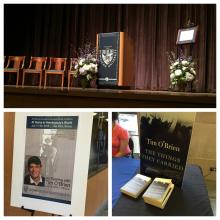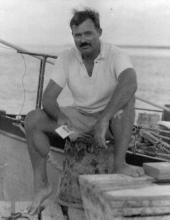Hemingway Review Blog
The Hemingway Review blog shares information on topics relevant to Hemingway, his writings, and the study of his work. It’s a more casual, less serious space for playful pieces and personal reflections. We will consider videos, audio recordings, slide presentations, photographs, and short pieces of writing (generally 250-500 words). Reflections on teaching and discussions of popular culture are welcome. Please review the blog's submission guidelines and contact Lisa Tyler, blog editor, at lisa.tyler@sinclair.edu if you are interested in contributing to the blog.
The Fall 2016 issue of The Hemingway Review has been published. This issue begins with a remarkable front cover, featuring an image from a booklet entitled “Don Ernesto en Pamplona” by Waldo Peirce. The painter drafted this booklet after his memorable trip to Pamplona with Hemingway in 1927.
Tribute to John Edmonds Sanford
Social histories of the twenties often account for opinions by referring to the response of groups to headline events. Many of these histories use familiar rubrics: the boom, the consumerism it induced, the moral and stylistic changes affecting different generations. The "Introduction to the Volume" of The Introduction concludes that Hemingway's letters and fiction are reliable evidence for the cost, nature, and value of things he observed.
Michael Reynolds wrote in The Young Hemingway (1986) that “not long after the movie of Roosevelt's African hunt played Oak Park, the Hemingway family-reunion picture shows young Ernest in his safari costume standing at the edge of the smilers. At his side he holds a hat like the one Teddy wore. In National Geographic, he devoured Roosevelt's account of the hunt, complete with pictures of dead animals and half-naked native women. Roosevelt's book African Game Trails became a permanent part of Hemingway's library.”
Thomas Bevilacqua brings his series to a close with toasts and trivia!
Our Man in Oak Park reboots mid-conference.
Tom talks about our evening with Tim O'Brien.
Celebrating Susan Beegel's editorship and the PEN Hemingway on board the Odyssey.
Our Man in Oak Park describes Monday sessions.
Thomas Bevilacqua, our man in Oak Park, summarizes the start of the festivities.
The Hemingway Review blog welcomes Thomas Bevilacqua as "Our Man in Oak Park." Tom will be offering a daily account of the Oak Park conference--stories, highlights, gossip (just kidding), and photos.
Mariel Hemingway is the granddaughter of Ernest Hemingway and Hadley Richardson, and daughter of Jack Hemingway, Ernest’s oldest son. On behalf of the Hemingway Review and the Newsletter, Wayne Catan conducted an interview with Mariel in which she discusses her acting career, her work with Woody Allen, the famous actor’s depiction of her grandfather in Midnight in Paris, the first Hemingway book she read (and wrote about), her work with suicide prevention, her newest book Out Came the Sun, and much more. Contributor Wayne Catan conducts the interview.
Ron Berman writes about "Books in the Background" of Hemingway scholarship in this new series of posts for the Hemingway Review blog. He will tackle all kinds of books that contribute to richer understanding of the context in which Hemingway lived and wrote. In this installment, he looks at books related to Prohibition.
The Hemingway legacy is long and wide, and the myths and fantasies that have grown around him are endless and often irrepressible. The bull-fighting warrior lover. The heroic soldier. The six-toed cats. Sometimes you don’t even know where to begin when the subject turns to some debatable piece of Hemingway lore.
The Spring 2016 issue celebrates the thirty-fifth anniversary of the Hemingway Review. We acknowledge this milestone with a special “anniversary features” section, which includes an interview with the founding editor of the Review, Charles M. “Tod” Oliver, and a creative piece by Kirk Curnutt that imagines how Hemingway felt on his thirty-fifth birthday through a series of imaginary letters to friends and family. Hemingway, for the first time since I am editor , graces the cover. In the image, he is, of course, thirty-five and looks out at us confidently from the deck of his recently acquired boat, Pilar.
Ron Berman writes about "Books in the Background" of Hemingway scholarship in this new series of posts for the Hemingway Review blog. He will tackle all kinds of books that contribute to richer understanding of the context in which Hemingway lived and wrote. In this installment, he looks at books related to photography.
Ron Berman writes about "Books in the Background" of Hemingway scholarship in this new series of posts for the Hemingway Review blog. He will tackle all kinds of books that contribute to richer understanding of the context in which Hemingway lived and wrote. In this installment, he looks at books related to The Great War.
Ron Berman writes about "Books in the Background" of Hemingway scholarship in this new series of posts for the Hemingway Review blog. He will tackle all kinds of books that contribute to richer understanding of the context in which Hemingway lived and wrote.

